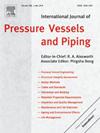Quantitative study on magnetic flux leakage internal detection signal of defects on the outer wall of bimetal composite pipes
IF 3
2区 工程技术
Q2 ENGINEERING, MECHANICAL
International Journal of Pressure Vessels and Piping
Pub Date : 2025-01-17
DOI:10.1016/j.ijpvp.2025.105438
引用次数: 0
Abstract
Bimetal composite pipes are widely used in oil and gas gathering pipelines due to their exceptional anti-corrosion and high-pressure resistance properties. However, the magnetic flux leakage (MFL) internal detection device for single-layer pipes is unsuitable for the bimetal composite pipe. It is difficult to detect the location and size of pipe defects in the outer layer. To solve the problem of poor detection performance for the bimetal composite pipe, this paper conducted a series of studies. Firstly, in this paper, the multi-layer media magnetic dipole model for bimetal composite pipes is established. Then, the influence of the thickness and permeability of the inner layer on the MFL signal of the outer wall defects is quantitatively studied. What's more, a MFL detection simulation model for bimetal composite pipes is established, and the detection rate of defects on the outer wall of bimetal composite pipes is improved by optimizing the design of the magnetization device. Finally, a defect size inversion method in the outer layer of bimetal composite pipes is proposed, which is validated by an indoor experimental test. The results indicate that compared to the case with the inner layer, the amplitude of axial and radial MFL signals raise by 74 % and 76 % respectively in the absence of an inner layer pipeline. The amplitude of the MFL signal of the outer wall defect decreases exponentially as the thickness and relative magnetic permeability of the inner layer increase. After optimizing the magnetization device, the magnetic induction intensity of the outer layer is increased by 29 %, and the detection rate of defects is increased by 37 %. The maximum error of the defect size inversion model is 6.4 %, which meets the requirements of engineering applications.
双金属复合管外壁缺陷漏磁内测信号的定量研究
双金属复合管具有优异的耐腐蚀、耐高压性能,在油气集输管道中得到广泛应用。然而,单层管道漏磁检测装置不适用于双金属复合管道。管道外层缺陷的位置和尺寸检测比较困难。为了解决双金属复合管检测性能差的问题,本文进行了一系列的研究。本文首先建立了双金属复合管的多层介质磁偶极子模型。然后,定量研究了内层厚度和磁导率对外壁缺陷漏磁信号的影响。建立了双金属复合管的MFL检测仿真模型,通过优化磁化装置的设计,提高了双金属复合管外壁缺陷的检出率。最后,提出了一种双金属复合管外层缺陷尺寸反演方法,并通过室内实验验证了该方法的有效性。结果表明,与有内层管道的情况相比,没有内层管道的情况下,轴向和径向磁振子信号的振幅分别提高了74%和76%。外壁缺陷的漏磁信号振幅随内层厚度和相对磁导率的增加呈指数递减。优化磁化装置后,外层磁感应强度提高29%,缺陷检出率提高37%。缺陷尺寸反演模型的最大误差为6.4%,满足工程应用的要求。
本文章由计算机程序翻译,如有差异,请以英文原文为准。
求助全文
约1分钟内获得全文
求助全文
来源期刊
CiteScore
5.30
自引率
13.30%
发文量
208
审稿时长
17 months
期刊介绍:
Pressure vessel engineering technology is of importance in many branches of industry. This journal publishes the latest research results and related information on all its associated aspects, with particular emphasis on the structural integrity assessment, maintenance and life extension of pressurised process engineering plants.
The anticipated coverage of the International Journal of Pressure Vessels and Piping ranges from simple mass-produced pressure vessels to large custom-built vessels and tanks. Pressure vessels technology is a developing field, and contributions on the following topics will therefore be welcome:
• Pressure vessel engineering
• Structural integrity assessment
• Design methods
• Codes and standards
• Fabrication and welding
• Materials properties requirements
• Inspection and quality management
• Maintenance and life extension
• Ageing and environmental effects
• Life management
Of particular importance are papers covering aspects of significant practical application which could lead to major improvements in economy, reliability and useful life. While most accepted papers represent the results of original applied research, critical reviews of topical interest by world-leading experts will also appear from time to time.
International Journal of Pressure Vessels and Piping is indispensable reading for engineering professionals involved in the energy, petrochemicals, process plant, transport, aerospace and related industries; for manufacturers of pressure vessels and ancillary equipment; and for academics pursuing research in these areas.

 求助内容:
求助内容: 应助结果提醒方式:
应助结果提醒方式:


